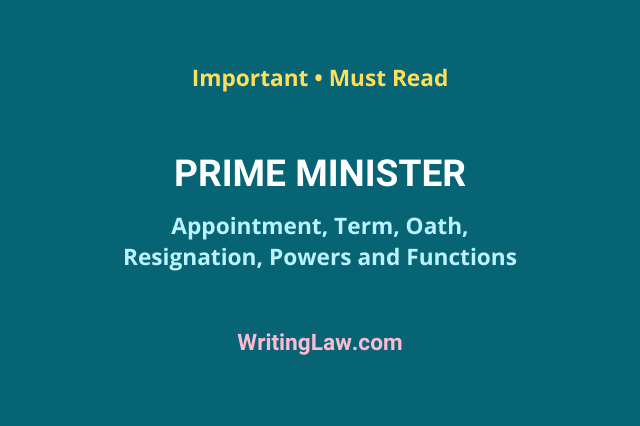
The Indian Prime Minister is the head of the government. According to Lord Morely, the Prime Minister is the primus inter pares, which means first among the equals and keystone of the cabinet arch. This article focuses on the appointment, oath, term, resignation, power and function of the Prime Minister of India. Let us have a look.
Appointment of the Indian Prime Minister
There is no such procedure laid down in the Constitution for the appointment of the Prime Minister of India. According to Article 75 of the Constitution, only the Prime Minister can be appointed by the President.
It can be further explained that the President has to appoint the leader of the majority party in Lok Sabha as the Prime Minister. However, the discretion can be exercised by the Indian President while appointing the Prime Minister when there is no party in the majority in Lok Sabha. Generally, in such a case, the leader of the largest party or coalition in Lok Sabha is appointed Prime Minister by the President. Then he is supposed to seek a vote of confidence in the house within a month.
Related: What Is the Vote of No Confidence in the Indian Parliament?
Oath to the Prime Minister of India
Before the Indian Prime Minister enters his office, the oath is administered by the President to him. The oath of office and the oath of secrecy are administered to the Prime Minister.
Term of the Prime Minister of India
The Indian Prime Minister’s term of office is not fixed. He holds the office at the pleasure of the President.
The term of the Prime Minister coincides with the normal term of Lok Sabha, which is five years. He may be re-elected, and no term limits are specified in the Constitution.
Resignation of the Indian Prime Minister
As long as the Prime Minister enjoys majority support in the Lok Sabha, he cannot be dismissed by the President. However, he has to resign, or the President can dismiss him if he loses the confidence of the Lok Sabha.
As the Prime Minister is the head of the Council of Ministers, the other ministers cannot work when the Prime Minister resigns or dies. In other words, the Council of Ministers dissolves on the death or resignation of the Prime Minister.
Powers and Functions of the Indian Prime Minister
Being the head of the government, various functions and powers are bestowed upon the Prime Minister of India. These are:
1. The Prime Minister recommends the President regarding the appointment of ministers. The nomination of members of the Council of Ministers is done by the Prime Minister to the President.
2. The allocation and reshuffling of various portfolios among ministers is done by the Prime Minister. If any portfolio is not allocated to any cabinet member, the Prime Minister may retain it.
3. The activities of the Council of Ministers are guided, coordinated and controlled by the Prime Minister.
4. The meeting of the Council of Ministers is presided over by the Prime Minister.
5. The Prime Minister has the power to ask a minister to resign or advise the President to dismiss him in any case of difference of opinion.
6. The resignation of the Prime Minister results in the collapse of the cabinet of ministers. The entire Council of Ministers dissolves on the death or resignation of the Prime Minister.
7. The Prime Minister advises the President regarding the appointment of:
(a) Attorney General of India.
(b) Comptroller Auditor General of India.
(c) Election Commissioners.
(d) Chairman and members of:
i) Union Public Service Commission,
ii) Finance Commission and so on.
8. The Prime Minister is bound to communicate the decision made by the Council of Ministers in relation to administrative affairs and legislative proposals, which the President may ask for.
9. The Prime Minister shall furnish the information as President may call for in relation to administrative affairs and legislative proposals.
10. If required by the President, the Prime Minister shall submit to the consideration of the Council of Ministers on any matter regarding which a decision has been taken by the minister but was not considered by the Council.
11. As the Prime Minister is the leader of the Lok Sabha, he has the power to:
(a) advise the President regarding the summoning and proroguing (discontinuing) session of parliament.
(b) recommend the President to Lok Sabha at any time.
(c) announce government policies on the floor of the house.
Other functions of the Prime Minister.
The Indian Prime Minister plays various roles like:
12. The Prime Minister is the chairman of the National Development Council, NITI Aayog, National Integration Council, Inter-State Council and National Water Resources Council.
13. The Prime Minister plays a vital role in shaping a country’s foreign policy.
14. The Prime Minister is the spokesman of the Union Government.
15. The Prime Minister is the crisis manager-in-chief at the political level during emergencies.
16. The Prime Minister of India is the leader of the party in power.
17. He is the political head of services.
Read Next:
1. Role and Duties of the Indian Prime Minister Are Written or Decisive?
2. What Is Anti-Defection Law as Per the Indian Constitution
- What Is a Foreign Judgement and When It’s Not Binding in India - 26th July 2022
- What Are Second Appeals Under Civil Law - 23rd June 2022
- Civil Appeal as Per the Civil Procedure Code - 12th June 2022







